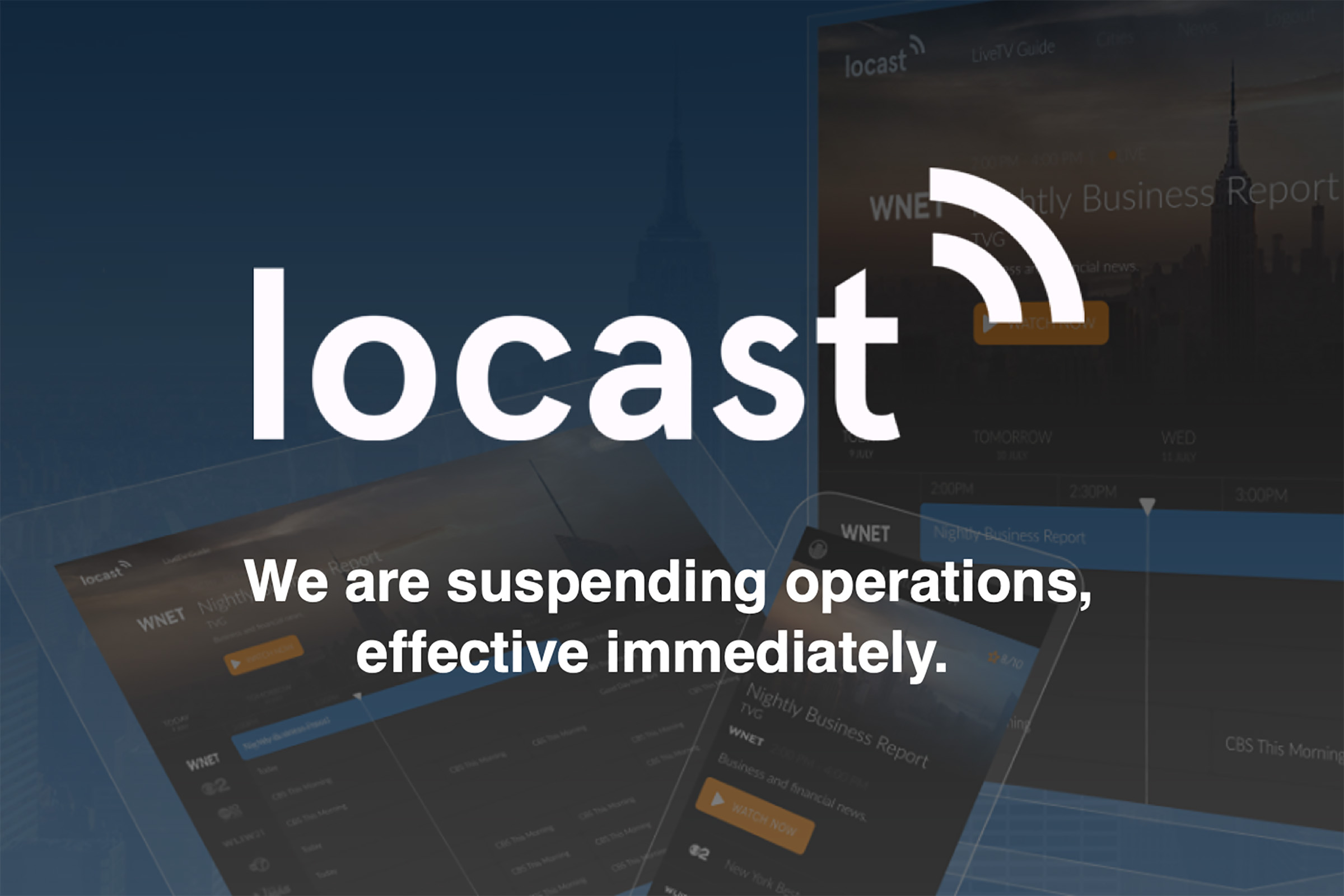Locast — the nonprofit service that streamed local broadcast TV channels from a few dozen major markets — has shut down for good after a temporary injunction became permanent, following initial summary judgment by a federal court. (That basically means the judge effectively said there’s no way you’re ever going to win this, and there’s absolutely no need for a trial to waste everyone’s time.)
On September 2, Locast sent an email that simply stated the following:
Locast Nation: As a nonprofit, Locast was designed from the very beginning to operate in accordance with the strict letter of the law, but in response to the court’s recent rulings, with which we respectfully disagree, we are hereby suspending operations, effective immediately.
Thank you.

For much of the country, this might not mean anything. But Locast became increasingly popular over the past couple of years, expanding to cover 35 designated market (DMA) areas — and 23 of the top 25 DMAs in the country.
Its reach included:
- Atlanta
- Baltimore
- Boston
- Charlotte, North Carolina
- Chicago
- Columbus, Ohio
- Dallas
- Denver
- Detroit
- Houston
- Indianapolis
- Los Angeles
- Madison, Wisconsin
- Miami
- Milwaukee
- Minneapolis
- New York
- Orlando, Florida
- Philadelphia
- Phoenix
- Pittsburgh
- Portland, Oregon
- Puerto Rico
- Raleigh, North Carolina
- Rapid City, South Dakota
- Sacramento, California
- San Francisco
- Scranton, Pennsylvania
- Seattle
- Sioux City, Iowa
- Sioux Falls, South Dakota
- Tampa Bay, Florida
- Tri-Cities, Washington
- Washington, D.C.
- West Palm Beach, Florida
Locast didn’t charge users to stream broadcast channels, instead relying on donations and its status as a nonprofit. It reported $4,856,219 in contributions and grants in 2020, up from $1,429,259 the previous year — about a 240 percent increase. Locast was operating on what it said was a provision that “allows broadcast translators to receive and transmit a primary local broadcast TV station without a copyright license.” The networks disagreed and filed suit in the summer of 2019.
And, so, Locast is no more. That doesn’t mean viewers won’t be able to watch their local broadcast affiliates any longer. Nor does it mean they won’t be able to do so for free — or at least for a minimal expenditure. Quite the opposite, in fact. They just won’t be able to do so via Locast.
Here are the best alternatives now that Locast has been shut down.

Watch local channels with an over-the-air antenna
This is how we used to watch TV in the olden days, when you could count the number of channels on both hands. And it still works today, and in fact is required by federal law to continue to work. The basics are this: You plug an antenna into your TV, and then your TV uses a built-in channel receiver to scan for the channels available in your area. You can then watch the likes of ABC, CBS, NBC, Fox, and more as much as you want, for free.
The only expenditure here is for an over-the-air (OTA) antenna. They’re increasingly affordable, depending on what sort you get. The basic rule of thumb when it comes to an OTA antenna is that mounting one outside is better than mounting it inside, and that higher is better. You’ll want to avoid trees and mountains and the like, if possible. Outdoor antennas typically allow for more range than indoor antennas, as well as less interference.
The direction you point the antenna also is important, as the broadcast signals themselves are directional. So if your local affiliates are coming from the east, you’ll want to point your antenna toward the east. West for west, north for north, etc. There are plenty of online tools and apps for your phone that will literally point you in the right direction, including from Antennas Direct (which also will conveniently sell you an over-the-air antenna).
There are limitations here. One antenna plugged into a TV means you’ll only be able to watch the local channels on that TV, and on no other devices. But there are fixes for that, too (see below).
And this all changes a good bit depending on your own circumstances — where you live geographically, the sort of house or building you’re in, etc.
Use an OTA antenna and a streaming box
If you’re a little more serious about using an OTA antenna to watch your local channels, you also should check out what we call an over-the-air streaming box. Instead of plugging the antenna directly into your television, you’ll plug it into a device that has multiple tuners and networking capability. You’ll then use an app on your TV, phone, or tablet to watch your local channels on multiple devices in your phone.
This is more expensive because you’re buying more hardware in addition to an antenna. But it’s also a one-time expenditure.
The most popular options here are HDHomeRun, Tablo, and AirTV.
HDHomeRun is a longtime favorite, and it’s pretty simple to use. You plug your antenna into the HDHomeRun box, then plug that into your router via Ethernet. Then you download the HDHomeRun app on whatever device you want, and start watching.
HDHomeRun has options for two or four tuners, meaning you could watch two different shows at once on two devices, or four shows on four devices. It also has a couple options for recording over-the-air programs on its own hardware, or you can toss some network-attached storage and a Plex server into the mix if you really know what you’re doing. Do note that recording capability costs another $35 a year, but that also extends your TV guide grid from one day’s worth of data to 14 days, in addition to other features.
HDHomeRun wins out in simplicity, but it struggles when it comes to its app experience. (Pro tip: It’s worth paying for the third-party Channels app.)

HDHomeRun starts at $100 for its most basic two-tuner box and ranges up to $280 for a four-tuner box with a built-in 1-terabyte hard drive. HDHomeRun also has a $200 ATSC 3.0-capable box that provides for NextGen TV, which allows for 4K broadcasts and more data for advertisers to use.
Tablo is another popular option and was the first to employ built-in recording options. You can bring your own hard drive and snag a $150 dual-tuner device, or grab one with a 1TB hard drive built in for $240.
Tablo has its own apps, too, which work across most major devices. Like HDHomeRun, it also has an optional subscription service that extends the live grid to 14 days and enables other searching and sorting features — as well as making it easy to watch outside your home. Subscriptions run $5 a month, $50 a year, or $180 if you want to pay for the life of the product.
One drawback of Tablo has to do with the way it works. Unlike HDHomeRun, which is using a straight MPEG2 feed, Tablo transcodes on the fly to h.264 to go easy on the bandwidth. But that takes a little time, and the overall experience tends to be slower. It’s something Tablo has improved over the years, and Tablo continues to have better app and grid experiences than HDHomeRun.
A third option is AirTV, which really is an extension of Sling TV. Like the other products listed above, you’ll plug your antenna into AirTV, and then plug AirTV into your television. But instead of having things in a separate app, your over-the-air channels will be listed alongside all the streaming channels in your Sling TV subscription.
That’s pretty handy if you’re already a Sling TV customer, and not so much if you’re not. The AirTV Mini dongle costs $80, while the two-tuner AirTV 2 lands at $100.
And for those who are way in on Amazon Fire TV, there’s Amazon Fire TV Recast. Think of it as a mash-up of Tablo and AirTV. It’s basically a box with tuners — either two tuners, or four tuners — along with either a 500-gigabyte or 1-terabyte hard drive. You plug your antenna into the Recast, and then it shares the feed either over Wi-Fi or Ethernet. Shows get shown in their own menu grid, or directly in your Amazon Fire OS listings, which is kind of cool.
The downside? It’s not cheap, at either $230 for the 2-tuner/500GB model, or $280 for 4 tuners and 1TB of storage.
Watch your local channels via a streaming service
Worth mentioning also is that the vast majority of DMAs also will find their local broadcast channels available via the major streaming services. That includes offerings like Hulu With Live TV, which is the largest live TV streaming service in the United States, YouTube TV (the second-largest), and DirecTV Stream (nee AT&T TV Now).
Things get ore dicey with Sling TV, which tends to miss out on certain networks — but that’s where AirTV comes in to fill in the gaps.



